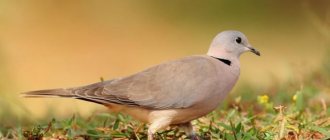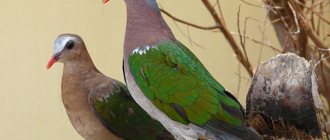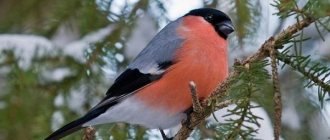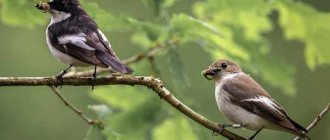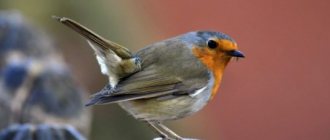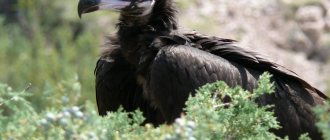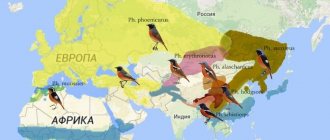Description and features of the turtle dove
The turtledove is a bird with a length of 22 to 28 centimeters. The bird weighs approximately 130 grams. The turtle dove from the city pigeon not only in its miniature size, but also in its slenderness, rounded tail, and red paws.
There are also differences in color. The top of the bird is painted brown. Some feathers have white stripes. The colors form a variegated pattern. The bird often has 2 stripes on its neck - black and white. They resemble a necklace.
What a turtle dove looks like is clear from photographs. However, anatomical features cannot always be seen in photographs. The pigeon is a new sky bird. They are the majority among modern species.
The palatine and pterygoid bones of turtle doves are connected. This allows the upper jaw to move easily relative to the skull. As a result, new palate birds can make complex movements with their beaks; their range is wide.
The description of the turtledove concerns not only its appearance, but also its voice. In most species of birds it is melodic and sad. The singing is like the babbling of a stream. In arid areas they even looked for water using the voice of doves.
Listen to the voice of the turtle dove
Ringed Dove
Common turtledove
Residents of desert regions have noticed that in the evenings pigeons flock to watering holes. This means that where there are pigeons, there is a stream, a lake, a spring. Therefore, listening to the singing of a turtle dove is doubly pleasant.
How to determine gender
Perhaps no one can accurately determine the sex of a turtle dove. There are some peculiarities in color, but you should not rely on shades. There are several distinctive features, but the owner will have to try to determine the sex of his bird from them.
- You should take the bird in a “column” and feel its pelvic bones. In the female they should be a little softer than in the male, but this difference can be quite difficult to discern.
- You can listen to the cooing, but this will not give a 100% result, since the females very skillfully parody the males.
- You can observe the bows of birds. After all, among these birds it is customary for the male to bow before the female. But even here you can get into trouble, since many females bow in response.
None of these methods can give a 100% guarantee.
Types of doves
There are about 10 species of turtle doves in nature. Five of them are found in Russia. One of the domestic species of pigeon does not so much sing as laugh. We are talking about the little dove. She is also called the laughing dove.
Little dove
It has bluish wing plumage, brown with blue-gray spots on the back, and red-wine on the head, chest, and neck. The latter has black markings on the sides. The flight feathers of the Little Dove have the same color.
Of all the turtle doves, the little dove is the only domesticated species. A bird weighing 130 grams is bred for its dietary, tasty meat. The birds' natural habitat is the south of Russia. Undomesticated individuals have a pronounced desire for cities and villages. Birds prefer to make nests near human settlements.
Other bird species found in Russia include:
- Great turtle dove . It reaches 34 centimeters in length. The weight is approximately 3 hundred grams. The bird's wingspan reaches 60 centimeters. It is unlikely that you will be able to see birds near settlements, like the little dove. Representatives of a large species climb into the depths of forests.
You can recognize the bird by its brown back and pink-brown belly. Black and white markings are mixed at the back of the neck. The marks are of the correct shape.
Great turtle dove
You can find a large loach by its voice only during the nesting period. The rest of the time, representatives of the species are silent. It makes no sense to look in the west of the country. Large turtle doves are not found south of the Urals.
- Ringed dove . In the line of sizes of family members it occupies 2nd place. The bird's body length is 30 centimeters. Fifteen of them are in the tail. In the ringed dove it is longer in comparison with the length of the body than in others. The tail has white and colored feathers.
The gray-brown back of the ringed dove is combined with a smoky pink head, neck, chest, and belly. The black and white necklace is prominent.
Ringed Dove
Behaviorally, the ringed dove is trusting and brave, often settling in cities. Settlements in western Russia and Europe are suitable. Being heat-loving, the ringed pigeon flies to cold weather, in particular to Africa.
- Diamond dove . Less small. The length of the bird is 20 centimeters, and the weight does not exceed 50 grams. The species was brought to Russia from Australia and is kept mainly at home. However, some of the birds released from captivity took root, becoming one of the migratory pigeons.
Diamond Dove
The Diamond Dove has ash-blue plumage. On the outside of the wings the color becomes intense gray. Among this “field” one can see a scattering of “diamonds” - white specks.
- Common turtle dove . It is up to 29 centimeters long and weighs 300 grams. The back of the dove is painted brick color. There is also a reddish tone on the turtle dove’s breast. The sides of the bird are black and white. Milky belly. Migratory species. By winter, turtle doves move from western Russia to Europe and Africa.
Outside Russia you can find the emerald dove. She has green feathers on her wings. At the same time, the flywheel part is black. The body of the bird is light brown. The turtle dove has a kind of cap on its head. It is made up of feathers of different colors. The beak is bright and orange. You can meet emerald pigeons in the humid forests of the tropics and subtropics.
Common turtledove
If the turtle dove in the photo has blue wings, tail and back, silver neck and belly, and a white head, it is an earth blue species. Its representatives live in Peru, Argentina, and Mexico. The size of the birds is close to the little dove, but, unlike it, they do not tolerate dry climates.
The spotted dove is found in China. The species was introduced from China to America and Australia. The color of the pigeon is brownish. The feathers on the head of the loach are pink. The name is justified by the extensive black spot on the neck. The mark is dotted with white dots.
Emerald Dove
The African species is also worth remembering. Its representatives are pinkish-brown. The birds' heads are gray with red rims to their eyes. The African pigeon must have a black and white collar on its neck.
Owners' opinions
Reviews about diamond doves are often positive. Many people say that the birds delight her with their singing every morning. However, some draw the attention of breeders to the fact that it is better not to house the turtle dove with other birds, as they will offend this little one. And the turtledove itself has such a calm and friendly character that it cannot even respond to its pugnacious neighbors.
In general, these birds are considered by everyone to be excellent pets. The only thing that upsets those who decide to become a breeder is the difficulty in determining the sex.
Lifestyle and habitat
The habitat depends on the type of dove. It has already been said that the spotted pigeon is Asian, the blue pigeon is American, and the diamond pigeon is Australian by birth. Doves from their northern habitat fly to Africa for the winter. There, most birds settle in the Sahara and Sudan. Pigeons from warm places lead a sedentary lifestyle.
Some turtle doves settle in attics and parks, while others climb away from people, into forests. By the way, most members of the family prefer deciduous forests. Mixed - a reserved option for doves from the northern territories. Birds do not settle in purely coniferous forests.
Ringed dove in the nest
In addition to full-fledged forests, turtle doves recognize thickets of bushes. The main thing is that there is a source of water nearby. Doves hide nests in vegetation. If the species is migratory, its representatives return to their breeding grounds in late April, early May.
Flights are made in groups of about 2 dozen individuals. Doves are removed from their homes in mid-August and early September. The exact dates depend on the breeding regions. Northern birds fly away earlier.
Interesting facts about the bird
- To better grind food in the stomach, the turtledove pecks small pebbles.
- He loves water and settles not far from bodies of water, where people chirp merrily and sing songs. Her cooing voice can be heard far in the forest, and hunters can determine the direction to the water.
- If there is enough food, couples can breed at any time of the year and raise up to 8 generations. A caring father raises the older ones, while the mother incubates a new clutch.
- As a rule, pigeons build nests in trees, but they can also settle on the ground.
- In the city, birds are not at all bothered by the bustle and noise. Settlements have been observed on busy streets, window sills and balconies.
Turtle doves are easily tamed and enjoy being kept as pets. The man fell in love with the bird for its calm character, quiet and melodious voice.
Still have questions about the Ringed Dove or have something to add? Then write to us about it in the comments, this will make the material more useful, complete and accurate.
Turtle dove feeding
Among turtle doves there are vegetarians and species that eat a mixed diet. The menu may include insects and small shellfish. From plant foods, turtle doves choose:
- grains of buckwheat, hemp, millet, wheat
- seeds of pine, alder, spruce, birch
- sunflower seed
Turtle doves peck sunflower seeds from the baskets. These pigeons damage crops. However, birds pick up other seeds and grains from the ground, without touching the ears or inflorescences. These turtle doves, on the contrary, help farmers by pecking, among other things, weed seeds.
Dove eggs
If a bird similar to a dove , it could be any other pigeon, for example, a wood pigeon. In addition to the urban gray, there are dozens of other species. The total number of pigeons on the planet is 400 million.
WHAT DOES IT EAT?
Ringed doves are a species of synanthropic birds whose lifestyle is closely related to humans. Birds willingly settle in urban and rural parks and gardens. Ringed doves feed on grains and seeds of cultivated plants grown in fields; in addition, they also collect seeds of wild grasses. Doves eat young shoots of grass, buds, flowers, and some fruits; they do not mind eating snails, worms and insects, which are intensively hunted during the period of raising offspring. The ringed dove stores the collected food in a crop formed by two processes of the esophagus. To ease the work of the stomach, the bird swallows small pebbles. Having filled its crop, it flies up into a tree and digests food there.
Reproduction and lifespan
The names of some turtle doves include the word “earthy.” This is an indication of the location chosen for the nest. Most pigeons hatch their chicks above the ground. Nests are built at a height of 0.5-6 meters, located on horizontally directed tree branches.
The turtle dove's nest is laid flat, unevenly filled with dry branches. Because of this, there are gaps in the structure. With a depth of 4 centimeters, the width of the nest is approximately 19 centimeters. This is enough to incubate 2 eggs with a diameter of about 2 and an average length of 3 centimeters. The male and female change positions.
Dove chicks
Dove eggs are white. Chicks appear on the 14th day after laying. Twenty days are spent on the plumage and rise to the wing. Until this time, teenagers choose to sit on the branches and, sometimes, fall. While still helpless, the birds die. Considering that there are only 2 chicks in the brood, the loss is significant. Therefore, turtle doves make 2-3 clutches per season.
In the wild, turtle doves live 5-7 years. Often, birds do not die a natural death. Doves have no defense mechanisms against predators. At home and in zoos, pigeons live up to 20 years. At the same time, caring for turtle doves is not difficult. Birds are unpretentious in food, easily get used to and even become attached to people, and rarely get sick.
ENEMIES
The most dangerous enemies of the turtle dove are birds of prey, mainly falcons. The turtledove flies faster than other pigeons, which sometimes allows it to avoid the sharp claws of the falcon. If the bird manages to fly to the forest, it will be saved, but it is difficult for it to hide in an open space. Bad weather conditions pose a danger to young and inexperienced birds, which fly very low, so the wind carries them under the guns of hunters.
At the beginning of summer there is little food, so turtle doves are often forced to leave their nests to find food. Squirrels and jays destroy a third of all dove nests. This happens at the beginning of summer, so the losses are small - wild turtle doves can have time to make a second clutch.
Signs associated with cranes
So, you already know which of the birds is cooing. Cranes have always been revered in Rus'. They were considered mystical birds, and many signs were associated with their appearance:
- In the old days, they believed that a crane wedge flying away in the fall carried with it the souls of the dead to the afterlife.
- In spring, on the contrary, it brings the souls of unborn babies. It was a particularly joyful event to encounter a crane wedge in the spring. Hearing a loud cooing in the sky, the peasants ran out into the street and turned to the birds with prayers for health and well-being. Cranes were often mentioned in ritual spring songs and chants.
- It was believed that whoever sees a pair of cranes for the first time in the spring will get married that year. And whoever meets the entire flock will soon be replenished in the family.
- A crane wedge in the sky is a harbinger of a thaw. “It became warm, and the beetle flew in, and he said: I brought it!”
- If the cranes fly to Orekhovy Spas, then there will be frost on Pokrov; if not, then winter will come later.
- If cranes fly to the southern countries alone, then there will be a poor harvest, and if in a flock, then we should expect a rich harvest.
High performance ratings at bird shows and competitions
Due to their positive characteristics, gray birds differ from their relatives in intelligence and quick intelligence. In performances and training, they are not inferior to eagles and parrots. It is important to remember that the turtle dove wins championships at shows and festivals with ease, performing complex tasks with precision, but to achieve high performance, you need to listen to the advice of ornithologists:
- Tame a bird for 2 years .
- Males make contact more often; they are larger than females and have darker plumage.
- Build a feeder with food and drink in front of the windows of your house or apartment.
- Patiently and slowly show yourself to the turtle doves while feeding, first from the window, then close, so that they get used to human presence.
- Create the right menu without salt additives to strengthen the muscular system of the bird's body.
- Drink only tap water, not boiled.
- Slowly switch to hand feeding, then the bird will no longer be afraid of neighbors.
- Gain complete trust.
- Leave doors or windows open in winter or autumn. Winged friends should feel supported during a difficult period for them.
- Once tamed, stroke along the growth of the plumage, otherwise you can injure the delicate skin of a living creature.
- It is necessary to train and teach strictly according to the developed scheme , since the structure of the turtledove’s brain is structured differently than that of its relatives, so a smart friend learns individual lessons completely and forever. After a certain period of time, he will repeat the material covered.
- Carefully monitor the condition of the claws and the color of the scaly covering on the paws (it should be dark pink). Brittle claws are the first sign of a lack of grain in a bird’s diet.
